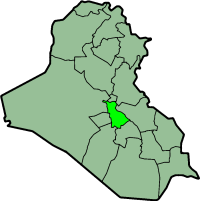Babylon Governorate
Babylon Governorate
Arabic: بابل | |
|---|---|
Governorate | |
 | |
| Country | Iraq |
| Capital | Al Hillah |
| Area | |
| • Total | 6,468 km2 (2,497 sq mi) |
| Population (2003) | |
| • Total | 1,751,900 |
| Main language(s) | Arabic |
Babil (Arabic: بابل) is a province in Iraq. It has an area of Template:Km2 to mi2, with an estimated population of 1,751,900 people in 2003.
The provincial capital is the town of al Hillah. The city Al Musayyib and the ancient ruins of Babylon (Babil, after which the region is named) are also in the province.
Before 1971 it was known as Hilla province. [1] The ancient city of Babylon in present-day Babil province was the capital of the Old Kingdom of Babylonia situated on the Euphrates River south of Baghdad in modern Iraq. The city was occupied from the 3rd millennium BC but became important early in the 2nd millennium under the kings of the First Dynasty of Babylon. The sixth king of this dynasty was Hammurabi (1792-1750 BC) who made Babylon the capital of a vast empire and is best remembered for his code of laws. This period was brought to an end by the Hittites when in 1595 BC Babylon is sacked by King Mursili I. The city then had a mixed history until the Neo-Babylonian Period of the 7th-6th centuries BC. It once again achieved pre-eminence when Nebuchadnezzar II (605-562 BC) extended the Chaldean Empire over most of Western Asia. Babylon fell to Cyrus the Great of Persia in 539 BC; occupation continued in the Achaemenid Period. The city was taken by Alexander the Great in 331 BC.
Recent DNA (Y chromosome) studies conducted by the National Geographic Magazine on the bones of ancient Babylonians and living people from Babil have shown that the modern peoples carry the same ancient Babylonian genetic material.[1]
References
- ^ McCurry, Steve (2005-02-20). "History: Mesopotamia". National Geographic.
{{cite web}}: Cite has empty unknown parameter:|1=(help)
